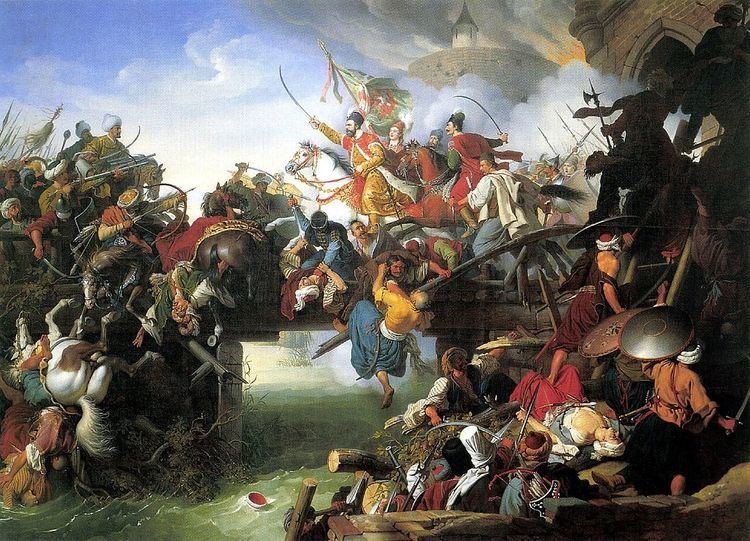Period 1493 – 1593 | ||
 | ||
Result Ottoman Empire conquered and subverted large areas of the Croatian Kingdom, their advance was conclusively halted in 1592. The remaining kingdom remained in the hands of the Habsburgs Similar | ||
The Hundred Years' Croatian–Ottoman War (Croatian: Stogodišnji hrvatsko-turski rat, Stogodišnji rat protiv Turaka, Stogodišnji rat s Osmanlijama) is the name for a sequence of conflicts, mostly of relatively low-intensity, ("Small War", Croatian: Mali rat) between the Ottoman Empire and the medieval Kingdom of Croatia (ruled by the Jagiellon and Zápolya dynasties), and the later Habsburg Kingdom of Croatia.
Contents
Pope Leo X called Croatia the Antemurale Christianitatis in 1519, given that Croatian soldiers made significant contributions to the struggle against the Turks. The advancement of the Ottoman Empire in Europe was stopped in 1593 on Croatian soil (Battle of Sisak). Nevertheless, the Muslim Ottoman Empire occupied parts of Croatia from the 16th to the end of the 17th century.
Time span
There are several different variations about the exact length of the war. According to one group of historians, the war began with the Battle of Krbava Field in 1493, and ended with the Battle of Sisak in 1593.
According to the other group of historians, the war lasted from the second half of the 15th century and into the entire 16th century.
A third group of historians mark the Peace of Zsitvatorok in 1606 as the end of the war. The war was won by the Ottoman's defeat upon their advance on the Kupa river border, with the remainder of Croatia's territory consisting of only 16,800 km².
In light of the human and territorial loss, and also from the modern Croatian Romanticist point of view, the 15th and 16th centuries were known as the "Two centuries of Croatia in mourning" (Latin: Plorantis Croatiae saecula duo carmine descripta) in the lyric-epic poem of Pavao Ritter Vitezović from 1703.
Battlefield
The battlefields were concentrated in the central-eastern areas of the Kingdom of Croatia, stretching from the eastern border of the pre-Ottoman times to the eastern border of the "reliquiae reliquiarum olim inclyti regni Croatiae" ("remnants of the remnants of the once great kingdom of Croatia").
After the 1493 loss at Krbava, the Ottomans started the occupation of significant forts: Knin and Skradin fell in 1522. The Battle of Mohács happened in 1526. Jajce fell in 1528, Požega in 1536, Klis fell in 1537, Nadin and Vrana in 1538, moving the Croatian-Ottoman border to the line, roughly, Požega-Bihać-Velebit-Zrmanja-Cetina.
By the end of 1540, the Ottoman Empire occupied the Croatian possessions between Skradin and Karin, eliminating them as a buffer zone between the Ottoman and Venetian territory in Dalmatia. By 1573, the remainder of the Dalmatian hinterland, now largely controlled by the Venetian cities, was even further reduced by Ottoman advances.
International impact
Although the Croatian Kingdom suffered major defeats in battles, it remained in existence, keeping its identity, religion and culture under the Habsburg Monarchy. In addition, some Croats in the territories lost to the Ottomans remained because the Porte embraced ethnic diversity, many of them eventually converting to Islam throughout the following centuries of Ottoman rule.
The Croatian combat against the Ottomans did not remain unnoticed in the political circles of European states. Copious amounts of information from the war was written in Monumenta Hungariae Historica, Codex diplomaticus partium Regno Hungariae adnexarum from 1903 (over 600 documents).
Type of conflicts
During those 100 years (or 150 years, depending on criteria), the war on the territory of Kingdom of Croatia was overall a series of smaller armed conflicts ("small war") over the long duration of the war (in other words, armies were not always in constant battle.)
The Ottoman tactic consisted of persistent loot and scorching raids whose aim was to intimidate and demoralize the local civil inhabitants, to exhaust the economic opportunities and disable the normal economic life on the frontier areas. On the other side, Croatian and allied Christian forces implemented counterattacks, especially in the first phases of war, when they were still able to apply the counterattacking or the offensive tactics. Despite these destructive tactics, the armies did sometimes clash. Sometimes the local armies intercepted or pursued the raiders in their return from the raid. There was also more intense military actions, such as the Battle of Krbava Field or the Battle of Sisak.
Zones of war peril
The war-endangered areas can be classified in three zones:
